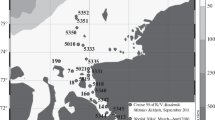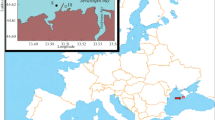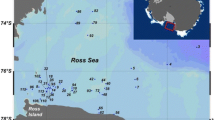Abstract
The dynamics of Antarctic coastal marine bacterioplankton has been studied over a 2-year period. Two field stations were sampled between one and three times a week in 1989 and 1991 in the “Terre Adélie” area. The survey included physicochemical (temperature and particulate organic matter) and bacteriological (total and heterotrophic counts, cell volume and frequency of dividing cells estimation) measurements. The results suggest that a strong interannual variability affects the total bacterial abundance, the mean cell volume, the percentage of free living cells and, to a lesser extent. the culturable saprophytic bacterial communities. The observed variability could be partly explained by a large deficit of solar irradiance during the 2nd year of study that may have affected sea ice and seawater primary production.
Similar content being viewed by others
References
Ackley SF, Buck KR, Taguchi S (1979) Standing crop of algae in the sea ice of the Weddell Sea region. Deep Sea Res 26:269–281
Albright LJ, McCrae SK (1987) Annual cycle of bacterial specific biovolumes in Howe Sound, a Canadian West Coast Fjord Sound. Appl Environ Microbiol 52:2739–2744
Azam F, Hodson RE (1977) Size distribution and activity of marine microheterotrophs. Limnol Oceanogr 22:492–501
Bhakoo M, Herbert RA (1980) Fatty acid and phospholipid composition of five psychrotrophicPseudomonas spp. grown at different temperatures. Arch Microbiol 126:51–55
Bölter M, Dawson R (1982) Heterotrophic utilization of biochemical compounds in Antarctic waters. Neth J Sea Res 16:315–332
Caron DA, Davis PG, Sieburth JMcN (1989) Factors responsible for the differences in cultural estimates and direct microscopical counts of populations of bactivorous nanoflagellates. Microb Ecol 18:89–104
Choi JW, Peters F (1992) Effects of temperature on two psychrophilic ecotypes of a heterotrophic nanoflagellate,Paraphysomonas imperforata. Appl Environ Microbiol 58:593–599
Chrzanowski TH, Crotty RD, Hubbard GJ (1988) Seasonal variation in cell volume of epilimnetic bacteria. Microb Ecol 16:155–163
Davidson AT, Marchant HJ (1992) Protist abundance and carbon concentration during aPhaeocystis-dominated bloom at an Antarctic coastal site. Polar Biol 12:387–395
Delille D (1990) Factors affecting the horizontal patchiness of coastal Antarctic seawater bacteria. Polar Biol 11:41–45
Delille D (1992) Marine bacterioplankton at the Weddell Sea ice edge: distribution of psychrophilic and psychrotrophic populations. Polar Biol 12:205–210
Delille D (1993) Seasonal changes in the abundance and composition of marine heterotrophic bacterial communities in an Antarctic coastal area. Polar Biol 13:463–470
Delille D, Bouvy M (1989) Bacterial responses to natural organic inputs in a marine sub-Antarctic area. Hydrobiologia 182:225–238
Delille D, Mallard L (1991) Influence of temperature on the growth potential of southern polar bacteria. Kiel Meeresforsch 8:213–218
Delille D, Perret E (1989) Influence of temperature on the growth potential of southern polar bacteria 18:117–123
Delille D, Bouvy M, Cahet G (1988) Short term variations of bacterioplankton in Antarctic zone: Terre Adélie area. Microb Ecol 15:293–309
Delille D, Fiala M, Rosiers C (1995) Seasonal changes in phytoplankton and bacterioplankton distribution at the ice-water interface in the Antarctic neritic area. Mar Ecol Prog Ser 123:225–233
Fabiano M, Povero P, Danovaro R (1993) Distribution and composition of particulate organic matter in the Ross Sea (Antarctica). Polar Biol 13:525–533
Ferguson RL, Rublee P (1976) Contribution of bacteria to coastal microplankton standing crop. Limnol Oceanogr 21:141–145
Fukunaga N, Russell NJ (1990) Membrane lipid composition and glucose uptake in two psychrotolerant bacteria from Antarctica. J Gen Microbiol 136:1669–1673
Garrison DL, Buck KR (1989) The biota of Antarctic pack ice in the Weddell Sea and Antarctic peninsula regions. Polar Biol 10:211–219
Garrison DL, Buck KR, Fryxell GA (1987) Algal assemblages in Antarctic pack-ice and in ice-edge plankton. J Phycol 23:564–572
Gibson JAE, Garrick RC, Burton HR (1990) The annual cycle of bacterial numbers at an inshore site near the Antarctic continent. Proc NIPR Symp Polar Biol 3:16–22
Gleitz M, Kirst GO (1991) Photosynthesis-irradiance relationships and carbon metabolism of different ice algal assemblages collected from Weddell Sea pack ice during austral spring (EPOS 1). Polar Biol 11:385–392
Hagström A, Larsson U (1984) Diel and seasonal variation in growth rates of pelagic bacteria. In: Hobbie JE, Williams PR (eds) Heterotrophic activity in the sea Plenum Press, New York pp 249–262
Hagström A, Larsson V, Horsted P, Normark S (1979) Frequency of dividing cells, a new approach to the determination of bacterial growth rates in aquatic environments. Appl Environ Microbiol 37:805–812
Hanson RB, Lowery HK (1985) Spatial distribution, structure, biomass and physiology of microbial assemblages across the Southern Ocean frontal zones during the late austral winter. Appl Environ Microbiol 49:1029–1039
Hobbie JE, Daley RJ, Jasper S (1977) Use of nuclepore filters for counting bacteria by fluorescence microscopy. Appl Environ Microbiol 33:1225–1228
Horner RA, Schrader GC (1982) Relative contribution of ice algae, phytoplankton, and benthic microalgae to primary production in nearshore regions of the Beaufort Sea. Arctic 35:485–503
Karl DM (1993) Microbial processes in the southern oceans. Antarctic Microbiology. Wiley, New York, pp 1–63
Koike I, Holm-Hansen O, Biggs DC (1986) Inorganic nutrient metabolism by Antarctic phytoplankton with special reference to ammonium cycling. Mar Ecol Prog Ser 30:105–116
Kottmeier ST, Sullivan CW (1988) Sea ice microbial communities, 9. Effects of temperature and salinity on rates of metabolism and growth of autotrophs and heterotrophs. Polar Biol 8:293–304
Kottmeier ST, Grossi M, Sullivan CW (1987) Sea ice microbial communities. VIII. Bacterial production in annual sea ice of McMurdo Sound, Antarctica. Mar Ecol Prog Ser 35:175–186
Kuosa H, Kivi K (1989) Bacteria and heterotrophic flagellates in the pelagic carbon cycle in the northern Baltic Sea. Mar Ecol Prog Ser 53:93–100
Li WKW, Dickie PM (1987) Temperature characteristics of photosynthetic and heterotrophic activities: seasonal variations in temperate microbial plankton. Appl Environ Microbiol 53:2282–2285
Palmisano AC, Sullivan CW (1983) Sea ice microbial communities (SIMCO). 1. Distribution, abundance, and primary production of ice microalgae in McMurdo Sound, Antarctica in 1980. Polar Biol 2:171–177
Pennock JR, Sharp JH (1986) Phytoplankton production in the Delaware Estuary: temporal and spatial variability. Mar Ecol Prog Ser 34:143–155
Pick FR, Caron DA (1987) Picoplankton and nanoplankton biomass in Lake Ontario: relative contribution of phototrophic and heterotrophic communities. Can J Fish Aquat Sci 44:2164–2172
Pomeroy LR, Deibel D (1986) Temperature regulation of bacterial activity during the spring bloom in Newfoundland coastal waters. Science 233:359–361
Rheinheimer G, Gocke K, Hoppe HG (1989) Vertical distribution of microbiological and hydrographic-chemical parameters in different areas of the Baltic Sea. Mar Ecol Prog Ser 52:55–70
Ronner U, Sorensson F, Holm-Hansen O (1983) Nitrogen assimilation by phytoplankton in the Scotia Sea. Polar Biol 2:137–147
Satoh H, Fukami K, Watanabe K, Takahashi E (1989) Seasonal changes in heterotrophic bacteria under fast ice near Syowa station, Antarctica. Can J Microbiol 35:329–333
Sherr EB, Rassoulzadegan F, Sherr BF (1989) Bacterivory by pelagic chereotrichous ciliates in coastal waters of the NW Meditterranean Sea. Mar Ecol Prog Ser 55:235–240
Smith REH, Clement P (1990) Heterotrophic activity and bacterial productivity in assemblages of microbes from sea ice in the high Arctic. Polar Biol 10:351–357
Smith REH, Clement P, Cota GF (1989) Population dynamics of bacteria in the Arctic sea ice. Microb Ecol 17:63–76
Smith WO, Nelson DM (1985) Phytoplankton bloom produced by a receding ice-edge in the Ross Sea: spatial coherence with the density field. Science 227:163–166
Sullivan CW, Palmisano AC (1984) Sea ice microbial communities: distribution, abundance and diversity of ice bacteria in McMurdo Sound, Antarctica in 1980. Appl Environ Microbiol 47:788–795
Tanoue E (1985) Distribution and chemical composition of particulate organic matter in the Pacific sector of the Antarctic Ocean. Trans Tokyo Univ Fish 6:43–57
Unanue M, Ayo B, Azua I, Barnica I, Iriberri J (1992) Temporal variability of attached and free-living bacteria in coastal waters. Microb Ecol 23:27–39
Vincent WE (1988) Microbial ecosystems of Antarctica. Cambridge University Press, Cambridge
Vosjan JH, Olanczuk-Neyman KM (1991) Influence of temperature on respiratory ETS-Activity of micro-organisms from Admiralty Bay, King George Island, Antarctica. Neth J Sea Res 28:221–225
Wiebe M, Sheldon WM, Pomeroy LR (1992) Bacterial growth in the cold: evidence for an enhanced substrate requirement. Appl Environ Microbiol 58:359–364
Wiebe WJ, Sheldon WM, Pomeroy LR (1993) Evidence for an enhanced substrate requirement by marine mesophilic bacterial isolates at minimal growth temperatures. Microb Ecol 25:151–159
Author information
Authors and Affiliations
Rights and permissions
About this article
Cite this article
Delille, D., Mallard, L. & Rosiers, C. Inter-annual variability in marine coastal Antarctic bacterioplankton. Polar Biol 16, 19–25 (1996). https://doi.org/10.1007/BF02388731
Received:
Accepted:
Issue Date:
DOI: https://doi.org/10.1007/BF02388731




